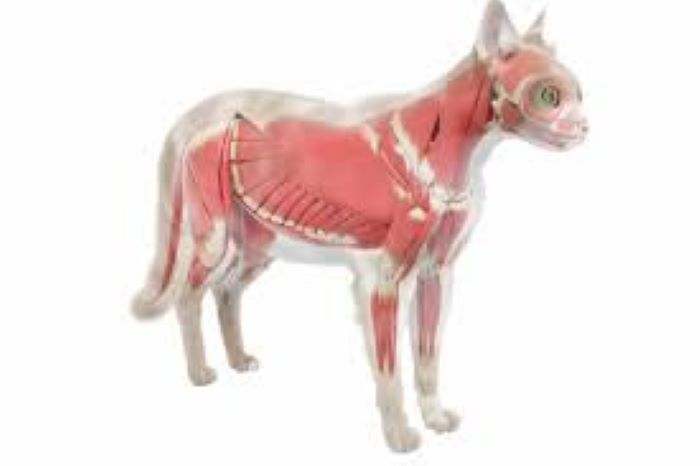There are about 500 muscles attached to a cat’s flexible skeleton. They allow the cat to use various gaits (patterns of locomotion) and to make an amazing range of graceful movements, suitable for an athletic hunter of small rodents and birds.
The cat’s muscles are adapted not only for the short bursts of speed necessary to chase down prey, or to escape from danger, but also for the barely imperceptible movements the cat makes before pouncing on prey.
Muscles allow a cat to move, eat, breathe, and pump blood around the body. Cats, and other vertebrates (animals with a backbone), have three types of muscle. Cardiac muscle is found only in the heart and works tirelessly to pump blood; smooth muscle occurs in the walls of many body structures, such as blood vessels and the digestive tract; and skeletal muscle is attached to the bones by tendons and allows a cat to move body parts, such as the limbs, tail, eyes, and ears, and maintains posture.
Skeletal muscle is also called striated, or striped, muscle because of its appearance under a microscope. These muscles often work in antagonistic pairs across joints—one contracts while the other relaxes—allowing a body part, such as a section of a limb, to alternately bend and flex.
Types of muscle fiber

Skeletal muscle tissue is made of bundles of long muscle cells called fibers. There are three types of fiber, depending on how quickly they work and tire. The most common type, “fast-twitch fatiguing” fibers contract and tire rapidly, and are used for short bursts of activity, such as sprinting and leaping.
Much less common, “fast-twitch fatigue-resistant” fibers work similarly but tire slowly, and are more prevalent in the muscles of endurance hunters such as dogs. After a burst of running, a cat has to stop and pant to cool down. “Slow-twitch” fibers contract and tire slowly and are used for precise, stealthy movements when stalking or remaining stock still before the pounce.
Cats use the sharp, curved claws at the ends of their toes for fighting, defending themselves, gripping, climbing, and scratching to leave scent marks. Most of the time, they are hidden away in protective flesh sheaths.
To expose, or bare, the claws, digital flexor muscles in the legs contract, tautening tendons and ligaments between the last two bones of the toes and pushing out the claws. At rest, a cat’s claws are retracted, avoiding wear and tear and remaining sharp. Tautening the ligaments and tendons in the toes forces the claws out.
Gaits
Unlike humans, who walk on their feet, cats walk on their toes. This type of locomotion of a cat is called digitigrade (Latin for “toe walking”) and enables them to move quickly and quietly. The forward thrust for all of their gaits (walking, trotting, and running) comes from the powerful muscles in the back legs.
When cats walk, the limbs move sequentially; right rear, right front, left rear, left front. The front legs swing inward, with the paws landing one after the other almost in a line under the cat’s body. The hind limbs swing inward, too, but not to the same extent. This gait enables a cat to walk along branches or narrow fence tops with confidence and ease. At such times, the tail is held aloft, helping the cat balance.
If the pace quickens to a trot, limbs that are diagonally opposite, such as the left forelimb and right hind leg, move together.
The floating forelimbs have extra maneuverability, helping to extend the cat’s stride. When running, the cat makes a series of bounds. The back legs push off together, with the airborne cat’s front legs touching down first, followed by the hind legs. When the cat stops, the front legs act as brakes.
Cats are adapted for short bursts of speed. Some domestic cats can run as fast as 30 mph (48 kph). By comparison, the fastest human can manage 27.79 mph (44.72 kph). Cats are not endurance hunters. The muscles in the cat’s back legs are powerful, but they tire quickly. They prefer to stalk their prey and can remain motionless for long periods, waiting for the right moment to pounce.
Flexibility
A highly flexible body and musculature offer a range of other movements, too. The supple spine enables the cat to arch when stretching (or when trying to appear bigger, such as when threatened), or curl into a circle when the cat is sleeping.
Flexibility is useful for grooming, too—the cat’s paws and tongue are able to reach almost all parts of the body. Strong hind leg muscles allow the cat to jump as high as 6½ft (2m) from a standing start, often twisting its body in midair to land safely. This movement is useful for catching birds as they try to make an airborne escape.
When climbing trees, the cat uses outstretched forelegs and claws like crampons, while the hind legs provide the power, propelling the animal up the tree. Descending, however, is a rather clumsy affair, with the cat scrabbling down backward in order to allow the forward-curving claws to be able to maintain a grip on the tree bark. The cat will finish the descent by turning its head and dropping the last metre or so to the ground.
Most cats do not like getting wet, but there are some cats that tolerate swimming, their stroke similar to doggy paddle.
If a cat loses its footing and falls from a tree, it has the innate ability to twist the right way up before it lands. Within one-tenth of a second, the vestibular apparatus of the inner ear, which monitors balance, senses disorientation.
A reflex reaction rotates the head so that the cat is looking downward. The front legs and then the hindquarters twist round, too, and the cat arches its back. Soft paw pads and flexible joints act as shock absorbers as the cat lands.
 The righting reflex allows cats to twist instinctively their body around into a safe position for landing when falling from a height. A cat’s flexible body amazingly rights itself in midair, without anything to push on.
The righting reflex allows cats to twist instinctively their body around into a safe position for landing when falling from a height. A cat’s flexible body amazingly rights itself in midair, without anything to push on.

